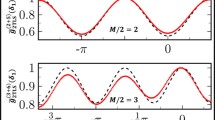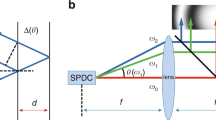Abstract
The accuracy with which the amplitude and phase of an interference fringe can be measured in quasi-thermal light is limited by the finite integration time used. The statistical errors expected in such a measurement are derived analytically, and their dependence on measurement time, the coherence time of the light, and the complex coherence factor are explored. An example illustrating the utility of the results is presented.
Similar content being viewed by others
References
The analytic signalu(P, t) has a real partu r (P, t) which is the actual real-valued wave disturbance, and an imaginary partu i (P, t) which is the Hilbert transform ofu r (P, t). For a discussion of analytic signals, see R.N. Bracewell:The Fourier Transform and its Applications (McGraw-Hill, New York 1965), pp. 267–272
E. Wolf: Proc. Roy. Society (A)225, 96 (1954);230, 226 (1955)
Throughout, a superbar over a symbol is used to indicate an infinite time average, or by ergodicity, an equivalent ensemble average
See, for example, J.W. Goodman: Synthetic Aperture Optics, inProgress in Optics, Vol. VII, ed. by E. Wolf (North-Holland Pub. Co., Amsterdam 1970), pp. 4–9
M. Born, E. Wolf:Principles of Optics, 2nd rev. Ed. (Pergamon Press, Oxoford 1964) Section 10.4.1
L. Mandel: J. Opt. Soc. Am.51, 1342 (1961)
S. Lowenthal, D. Joyeaux: J. Opt. Soc. Am.61, 847 (1971)
L. Mandel: Proc. Phys. Soc.72, 1037 (1958)
D. Middleton:An Introduction to Statistical Communication Theory (McGraw-Hill New York 1960) Section 7.7
P. Beckmann:Probability in Communication Engineering (Harcourt, Brace & World, Inc., New York 1967) Section 4.4
See Ref.—:Probability in Communication Engineering (Harcourt, Brace & World, Inc., New York 1967), Section 4.6
J.B. Thomas:An Introduction to Statistical Communication Theory (John Wiley & Sons New York 1969) Section 4.8
See Ref.—:An Introduction to Statistical Communication Theory (John Wiley & Sons New York 1969), Fig. 4.8
The symbolE[·] is used to represent a statistical expectation operator
See Ref.—:An Introduction to Statistical Communication Theory (John Wiley & Sons New York 1969), p. 168
Author information
Authors and Affiliations
Additional information
Work supported by the Office of Naval Research
Rights and permissions
About this article
Cite this article
Goodman, J.W. Statistical properties of mutual intensity with finite measurement time. Appl. Phys. 2, 95–101 (1973). https://doi.org/10.1007/BF00934178
Received:
Issue Date:
DOI: https://doi.org/10.1007/BF00934178




